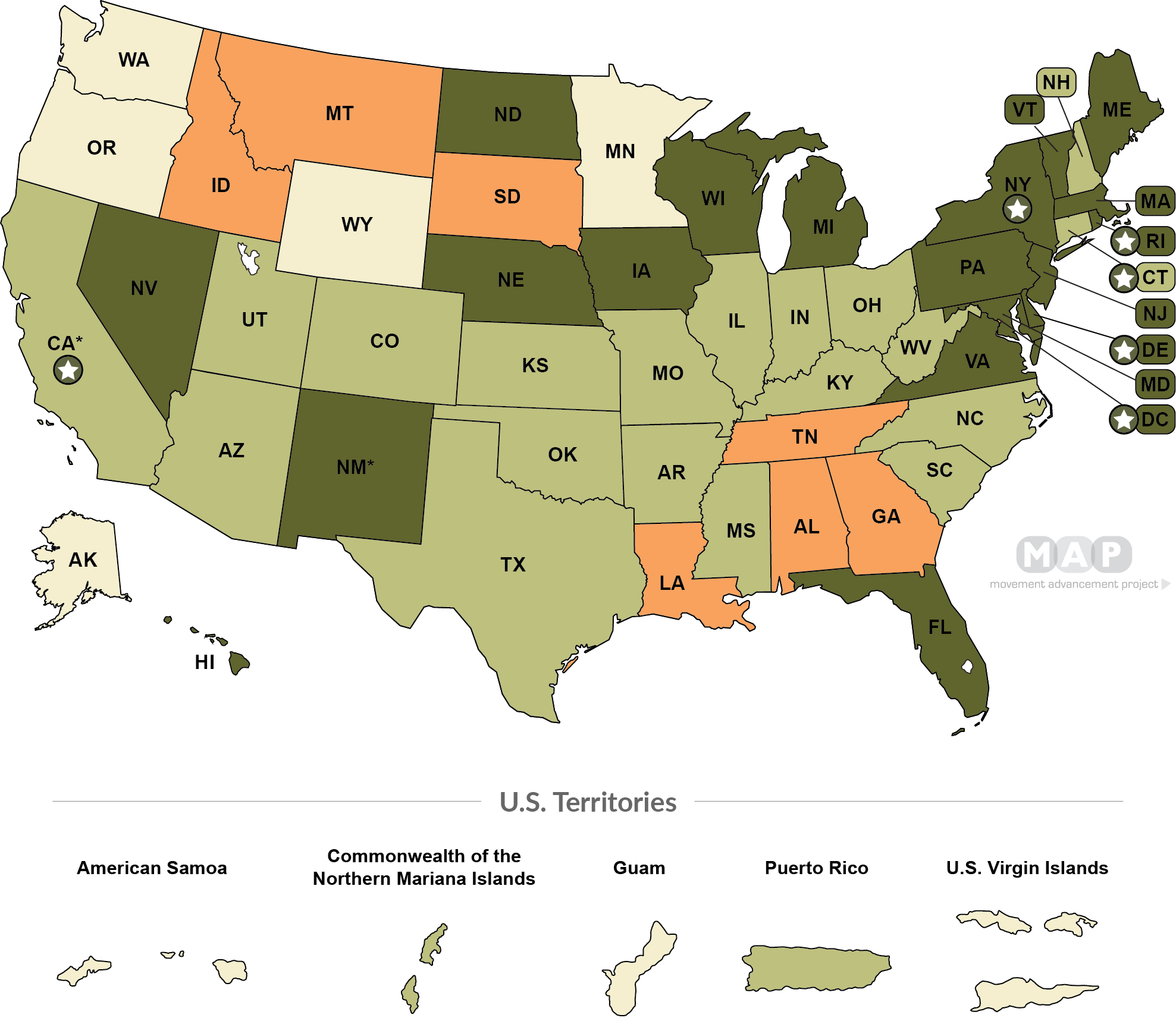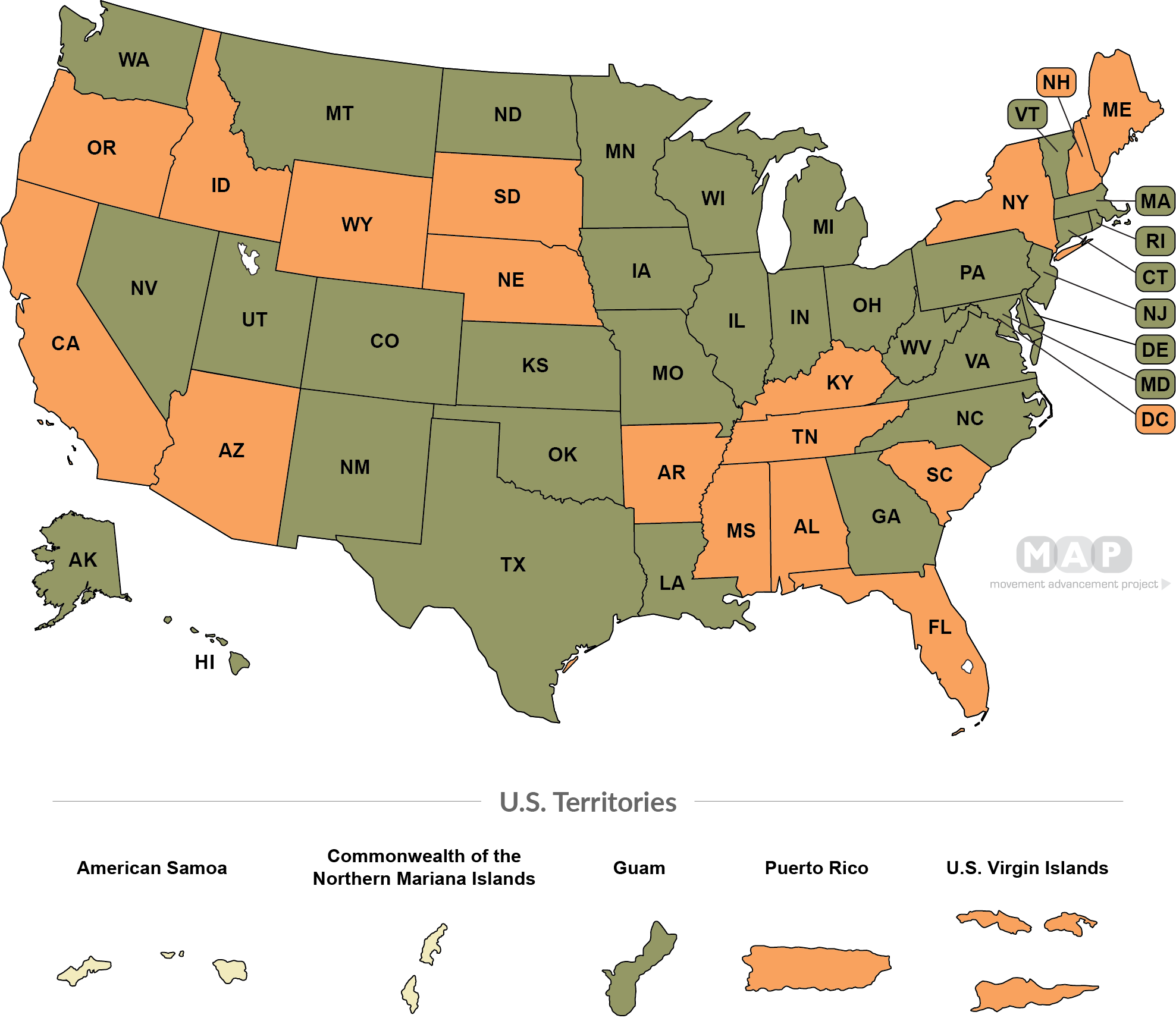The
Behavioral Risk Factor Surveillance System (BRFSS)
is the largest continuously conducted health survey in the world. States can opt to include a number of modules with added questions, including questions about sexual orientation and gender identity. The below map is based on
participation in the 2022 BRFSS.
Information about 2023 participation has not yet been released.
State includes questions about sexual orientation and gender identity in state-based BRFSS survey of adults (33 states, 1 territory)
State does not include sexual orientation and gender identity module in its state-based BRFSS survey of adults (17 states , 2 territories + D.C.)
State does not participate in the BRFSS (0 states, 2 territories)
Percent of Adult LGBTQ Population Covered by Laws
*Note: These percentages reflect estimates of the LGBTQ adult population living in the 50 states and the District of Columbia. Estimates of the LGBTQ adult population in the five inhabited U.S. territories are not available, and so cannot be reflected here. Population estimates are from The Williams Institute.
58 % of LGBTQ Americans living in a state that includes questions about sexual orientation and gender identity in state-based BRFSS survey of adults.
42 % of LGBTQ Americans living in a state that does not include questions about sexual orientation and gender identity in state-based BRFSS survey of adults.
0 % of LGBTQ Americans living in a state that does not participate in the BRFSS.
The Youth Risk Behavior Surveillance System (YRBSS)
is a set of school-based surveys of youth and young adults, conducted every other year by the Centers for Disease Control and Prevention (CDC) in high schools across the country. States (and some school districts) can choose whether to include questions about sexual orientation, gender identity, and/or gender expression. The below map reflects each state's choices regarding the inclusion of these questions in the 2021 state-based YRBSS. Information about 2023 participation has not yet been released.

State includes questions about sexual orientation and gender identity in state-based YRBSS survey of youth (19 states + D.C.)
State includes questions about sexual orientation only in state-based YRBSS survey of youth (19 states, 2 territories)
State does not include questions about sexual orientation or gender identity in state-based YRBSS survey of youth (7 states)
State does not participate in the YRBSS (5 states, 3 territories)

State includes question about gender expression in state-based YRBSS survey of youth (5 states + D.C.)
*Notes: -In 2021, New Mexico asked a transgender status question but using different wording. Because of this different wording, the CDC does not list NM as having asked the transgender status question. We include New Mexico here given our focus on whether states are choosing to collect data about sexual orientation and gender identity in their YRBSS efforts.-In 2021, California did not have a high enough participation rate to generate reliable data for the whole state, but it still asked the sexual orientation and gender expression questions. -Some states that do not participate in the YRBSS have their own similar statewide studies of youth, including the Minnesota Student Survey, the Oregon Healthy Teens Survey (2001-2019) / Student Health Survey (since 2020), the Washington Healthy Youth Survey, and the Wyoming Prevention Needs Assessment Survey. While these studies are also important, participating in the YRBSS helps create not only state-level pictures but also a larger national picture and the ability to study the same data and questions across students in all states. To learn more, visit the YRBSS website.
Recommended citation:
Movement Advancement Project. "Equality Maps: Data Collection." https://www.lgbtmap.org/equality-maps/data_collection. Accessed 12/17/2025.
Percent of LGBTQ Youth Covered by Laws
*Note: These percentages reflect estimates of the LGBTQ youth (ages 13-17) population living in the 50 states and the District of Columbia. Estimates of LGBTQ youth in the U.S. territories or under age 13 are not available, and so cannot be reflected here. Population estimates are from The Williams Institute.
37 % of LGBTQ Americans living in a state that includes questions about sexual orientation and gender identity in state-based YRBSS survey of youth.
48 % of LGBTQ Americans living in a state that includes questions about sexual orientation and gender identity in state-based YRBSS survey of youth.
8 % of LGBTQ Americans living in a state that does include questions about sexual orientation or gender identity in state-based YRBSS survey of youth.
6 % of LGBTQ Americans living in a state that does not participate in the YRBSS.




